|
Once we had the heels worked out, it was time to level the foot and trim excess horn growth. It was our intent to leave as much grey line material as possible as this was to be our primary base of support.
As was predicted by Dr. Bowker and Mr. Ovnicek, the sole revealed a natural rim near the grey line where it would naturally want to contact the ground.
|
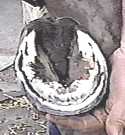
|
|
Since we had established where our toe actually belonged, we rasped off the face and underside of the toe to form a bold foot with a rockered toe which broke over at about 1 1/4" in front of the apex of the frog.
We compared our measurements with the natural "read" of the sole, and the definition of solar structure did in fact show us that it intended to support weight and expect a break-over at the distance that Bowker and Ovnicek predicted.
|
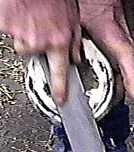
|
|
Remember the nail I drove into the foot at the beginning of this experiment?
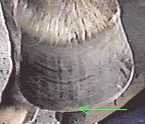 Highlighted in bright green are the holes in the finished shoe. As you can see, they are actually closer to the edge than old horseshoe nail holes would be. All of the material forward of the nail in the first photo was excess toe. If the difference between a new and worn shoe can affect breakover and performance, consider what this inch or so of excess toe must have been doing.
Highlighted in bright green are the holes in the finished shoe. As you can see, they are actually closer to the edge than old horseshoe nail holes would be. All of the material forward of the nail in the first photo was excess toe. If the difference between a new and worn shoe can affect breakover and performance, consider what this inch or so of excess toe must have been doing.
|
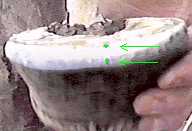
|
|
Here is the properly trimmed foot in relationship to the other foot which is yet to be trimmed. The difference is astounding. What will be even more interesting to see is how much heel in relation to toe we will have when the horse comes due next time. If the four point theory pans out, the structures in this hoof should attempt to grow more in balance and we should have a more correct looking hoof at the end of the growth cycle.
|
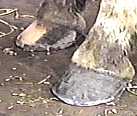
|
|
Here is one more photograph worth noting. This is of the other QH which was trimmed this day. We picked up his foot after he had been standing on a wet mat and the resulting stains clearly showed contact at the same four points as the wild horse's foot would contact the ground. This horse is a stumbler so it will be interesting to see how he responds to the trim.
Note:
We left the heel bars intact in these horses as they exhibited long toes and weak heels. On subjects that tend to produce overgrown heels we pare out the heel bars to allow more heel flexion and leave less material to contact the ground so that the heels would wear more quickly in proportion to the toes. On more naturally wearing hooves we will take out heel bar overgrowth but not be as aggressive as we would with horses that tend to have "high heels."
|
 |